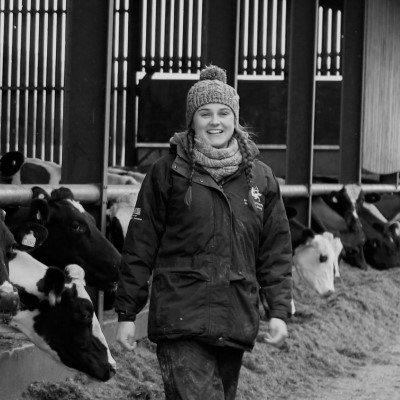CIEL | Blog: Data Focus – Turning carbon audits on their head
Guest blog from Hugh Martineau, Map of Ag

We’re delighted CIEL Member Map of Ag have written a blog offering their insight and experience on why there should be a focus on data and why the industry should ‘turn carbon audits on their head’.
Map of Ag specialise in the integration of farm data and in its analysis and modelling. Their global data platform enables clients to generate insight of their food supply chains by connecting directly or indirectly through farm data to primary producers. By appropriately structuring this data, clients can answer the questions most relevant to their business. These questions may be about any farm-related activity, from compliance or assurance, to the environment, animal welfare, antibiotic usage or production metrics.
Management, data and greenhouse gas (GHG) emissions are all inextricably linked but there’s a better way of looking at the sustainability opportunity, argues Hugh Martineau, Head of sustainability at Map of Ag
Farmers are metaphorically drowning in data, and yet the inability to bring it all together onto one platform is limiting how well they can use it to improve productivity and efficiencies. Adding GHG assessments to the list could potentially layer on another ineffective set of figures which yield no value to the business, but there is a better way.
GHG assessments have the potential to be massively valuable to farmers, because reducing emissions goes hand in hand with improving business efficiencies. And reports can be produced from existing data, significantly reducing the need for additional data collection.
What should you focus on?
Right now, everyone is talking about the need to have one “carbon calculator” recognised for use across the industry. And I can see why. There are so many different ones out there and many are just consuming data without necessarily adding anything to the farm. You end up sticking lots of information into these black boxes and they come up with a figure that’s largely irrelevant.
But we shouldn’t be focusing on the tool. It’s far more important to be considering the data that goes into it. Rubbish data gives rubbish answers. If you put accurate information in, then you will be able to get a better understanding of what you can do to influence the outcome.
So we should be turning these carbon audits on their head. Rather than taking a snapshot of the farm on any one day, we should be using a system which adds context and reflects the multi-annual system of farming.
That way, farmers can use the data to drive business decisions, which in turn improve efficiencies and therefore reduces their carbon footprint. It’s a win-win.
So what data should we be using?
I think it should be information which farmers already collect for key performance indicators (KPIs). Fertility statistics, weight gain, age at first calving, feed intakes, milk yields – all of these are central to a farm business’s profit margin.
The more efficient the system, the more productivity farmers can realise, potentially from lower inputs. That benefits both the environment and the bottom line. It’s all about the relationship between inputs – feed, fertiliser, fuel, stock – and management of the biological processes which then produce the outputs – milk, meat, crops and so on.
Bringing the data together in this way means it is infinitely more powerful for the farmer – examining efficiencies feeds into management tweaks for further improvements. It’s a virtuous circle with tangible benefits. Producers can look at where they are, benchmark against others, and plan for where they want to be.
Transforming data into insight
At Map of Ag we’ve been working with Morrisons, measuring and monitoring beef information across the supply base. We’ve then calculated emissions on a per animal, per day, basis. Using British Cattle Movement Service (BCMS) information and slaughter statistics, it’s easy to work out the carbon emissions per kg deadweight, which is a really important figure.
And presenting the information in graphic form makes it easy for the farmer to read and respond to. We can drill down to compare steers and heifers – on some farms the former will be finished and the latter sold as stores; you can’t have the same management for both and we need to recognise that. But using the information to reduce days to slaughter and meet processor specifications will be more efficient, both for the business and the carbon footprint.
Analysing data in this way is far more insightful than just churning out a one-off carbon emission figure. It allows producers to undertake scenario planning; if they finish stock a month earlier, reduce fertiliser use or soya in rations, what impact will it have on both productivity and emissions?
It turns the whole greenhouse gas discussion into language that relates directly to management decisions and farm profitability. And having it all on one platform eliminates the incessant doubling up of data entry. Nutrient management plans, carbon audits, farm assurance, KPIs – in practice they’re all linked. It’s high time we stopped looking at them as separate entities and extracted real value from bringing them together.
CIEL is really pleased to bring you insight on making the most of data from experts across the CIEL Network over the next couple of weeks. Keep checking back on the CIEL blog pages regularly, or follow CIEL on Twitter and LinkedIn for a heads up on new instalments on this mini ‘data discussion’ series. CIEL would love to hear your views and experiences too, so drop a line on the enquiry web form.
If you are interested in our Member Exclusive CIEL Insights ‘Data Discussion’ Webinar, watch it here.
Interested in becoming a CIEL Member? Get in touch.


Hugh Martineau, Head of Sustainability at Map of Ag
A major focus area has been in relation to climate change mitigation; developing measuring and monitoring programmes for greenhouse gas emissions and removals including assessment of ‘Net Zero’ emissions strategies.







